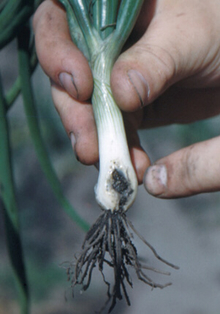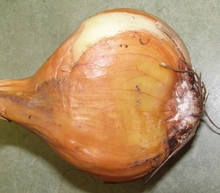Quick facts
This page highlights non-chemical practices to prevent or manage common insect and disease problems of onions.
For more detailed information follow the links in each section.
Click on an image to enlarge it.
Cutworms
- Remove weeds and plant residue.
- Till garden before planting.
- Place cardboard collars or aluminum foil around plant stems when planting transplants.
More information on cutworms.
Onion maggot
- Avoid using animal manure or green manure in spring.
- When possible, delay planting onions until after June 1.
- Remove and destroy host plants in fall.
- Cover plants with a row cover (light weight fabric) in spring.
- Don't plant onions in the same area in consecutive years.
More information on onion maggot.
Purple blotch
- Yellow storage onions are more resistant than Spanish onions.
- Use drip irrigation.
- Don't leave culls near field.
- After harvest, remove and destroy or bury any infected leaves.
- Don't plant onions, leeks or shallots in the same field for 3-4 years.
Fusarium basal rot
- Plant varieties with tolerance or resistance to disease.
- Plant in well drained soil or use raised beds to improve drainage.
- Don't plant onions, shallots, garlic or chives in the same field for 4 years.
Reviewed in 2019









